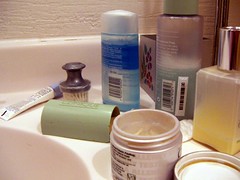 Image by A30_Tsitika via Flickr
Image by A30_Tsitika via FlickrIn seeking that springtime fresh feeling, what price are we paying with our health? Regular studies are being conducted that are raising compelling questions that need answers. Oftentimes, the results of the study are deemed 'inconclusive' and the product remains on the market for decades before being removed by the FDA, if at all.
In the article, "Dangerous chemical in Deodorant and Antiperspirant: A detailed review of the Chemicals, Research and Avoidance tips" http://www.naturalcosmeticnews.com/ an investigative look is taken at some of the more common chemicals. I have included a summary of the results in this article.
Names too long to pronounce
Have you taken a look at some of the long names of the chemicals in these products? They are very ominous sounding to say the very least.
Below is a list of some of the more common additives that are found in deodorants and other personal care items. Also note, that many of these same chemcials are found in foods.
Propylene glycol
I found out several years ago while selling cosmetics for a national sales company that this chemical is found everywhere - foods, such as ice cream, lotions, hair care products as well as deodorants. Originally, these preservative were used in anti-freeze! This chemical however, keeps products from drying out. It can cause GI irritation: nausea, vomiting, and headache.
Aluminum
Commonly used in deodorants because it keeps sweat glands from secreting sweat, at least, it slows its reaching the skin surface. These compounds can cause changes in estrogen receptors in the breast, which can cause changes in breast cell tissue.
It is also being connected with neurological disease such as Alzheimer's disease.
Parabens
There is a group of chemicals that fall in this category they are:
methylparaben ethylparaben
propylparaben natylparaben
All of these chemicals can bring about estrogenic changes in breast tissue as well. Possible link to breast cancer have been suggested, although not proven
FD&C Colors
These chemicals have been around for a number of years and have been present in foods for decades. It has been suggested that they are carcinogenic, but, apparently the linked has not been proven to the extent necessary for the FDA to remove them, as foods and personal care items still contain them. Examples are: candies, jellos and personal care products.
TEA/DEA
These chemical adjust the ph in products and can also cause liver and kidney damage.
Incidentally, they are banned in Europe.
In summary
It often takes the FDA years to remove a product form the market. In the meantime, millions could be affected by the dangerous and adverse reactions that these chemicals are suspected of causing. Caveat emptor.
Decide for yourself what you think is safe for yourself and family.

No comments:
Post a Comment